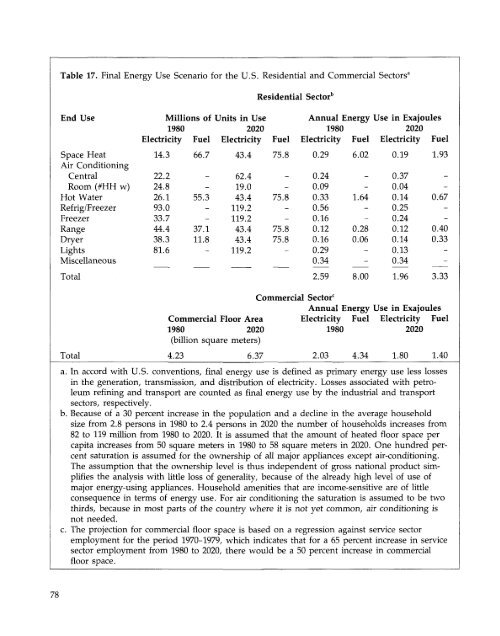ENERGY FOR A SUSTAINABLE WORLD - World Resources Institute
ENERGY FOR A SUSTAINABLE WORLD - World Resources Institute
ENERGY FOR A SUSTAINABLE WORLD - World Resources Institute
Create successful ePaper yourself
Turn your PDF publications into a flip-book with our unique Google optimized e-Paper software.
Table 17. Final Energy Use Scenario for the U.S. Residential and Commercial Sectors 8<br />
End Use<br />
Space Heat<br />
Air Conditioning<br />
Central<br />
Room (#HH w)<br />
Hot Water<br />
Refrig/Freezer<br />
Freezer<br />
Range<br />
Dryer<br />
Lights<br />
Miscellaneous<br />
Millions of<br />
1980<br />
Electricity Fuel<br />
14.3<br />
22.2<br />
24.8<br />
26.1<br />
93.0<br />
33.7<br />
44.4<br />
38.3<br />
81.6<br />
66.7<br />
-<br />
-<br />
55.3<br />
-<br />
-<br />
37.1<br />
11.8<br />
-<br />
Units in Use<br />
2020<br />
Electricity<br />
43.4<br />
62.4<br />
19.0<br />
43.4<br />
119.2<br />
119.2<br />
43.4<br />
43.4<br />
119.2<br />
Residential Sector*<br />
Fuel<br />
75.8<br />
-<br />
-<br />
75.8<br />
-<br />
-<br />
75.8<br />
75.8<br />
-<br />
Annual Energy Use in Exajoules<br />
1980<br />
2020<br />
Electricity Fuel Electricity Fuel<br />
0.29<br />
0.24<br />
0.09<br />
0.33<br />
0.56<br />
0.16<br />
0.12<br />
0.16<br />
0.29<br />
0.34<br />
6.02<br />
-<br />
-<br />
1.64<br />
-<br />
-<br />
0.28<br />
0.06<br />
-<br />
-<br />
0.19<br />
0.37<br />
0.04<br />
0.14<br />
0.25<br />
0.24<br />
0.12<br />
0.14<br />
0.13<br />
0.34<br />
Total 2.59 8.00 1.96 3.33<br />
Total<br />
1.93<br />
-<br />
-<br />
0.67<br />
-<br />
-<br />
0.40<br />
0.33<br />
-<br />
-<br />
Commercial Sector 0<br />
Annual Energy Use in Exajoules<br />
Commercial Floor Area Electricity Fuel Electricity Fuel<br />
1980 2020 1980 2020<br />
(billion square meters)<br />
4.23 6.37 2.03 4.34 1.80 1.40<br />
a. In accord with U.S. conventions, final energy use is defined as primary energy use less losses<br />
in the generation, transmission, and distribution of electricity. Losses associated with petroleum<br />
refining and transport are counted as final energy use by the industrial and transport<br />
sectors, respectively.<br />
b. Because of a 30 percent increase in the population and a decline in the average household<br />
size from 2.8 persons in 1980 to 2.4 persons in 2020 the number of households increases from<br />
82 to 119 million from 1980 to 2020. It is assumed that the amount of heated floor space per<br />
capita increases from 50 square meters in 1980 to 58 square meters in 2020. One hundred percent<br />
saturation is assumed for the ownership of all major appliances except air-conditioning.<br />
The assumption that the ownership level is thus independent of gross national product simplifies<br />
the analysis with little loss of generality, because of the already high level of use of<br />
major energy-using appliances. Household amenities that are income-sensitive are of little<br />
consequence in terms of energy use. For air conditioning the saturation is assumed to be two<br />
thirds, because in most parts of the country where it is not yet common, air conditioning is<br />
not needed.<br />
c. The projection for commercial floor space is based on a regression against service sector<br />
employment for the period 1970-1979, which indicates that for a 65 percent increase in service<br />
sector employment from 1980 to 2020, there would be a 50 percent increase in commercial<br />
floor space.<br />
78

















